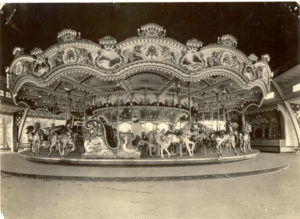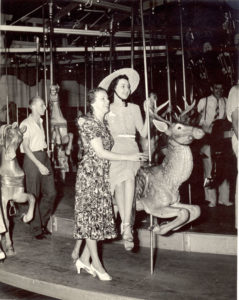Hersheypark Rides: Carrousels

Hersheypark has been home to three different carrousels or merry-go-rounds over the years.
Hershey Park’s first carrousel began operating in 1908. One of Hershey Chocolate’s salesmen, who had seen one while out traveling on business, thought the Park should have one. He also knew where the Park could buy a good secondhand machine. He told Harry Lebkicher who thought it would be a great addition to the Park, but Milton Hershey was unimpressed. “That can wait,” Mr. Hershey said. But shortly after the Park’s 1908 opening day he changed his mind and Hershey Park purchased a small, used merry-go-round and band organ from the Herschell Spillman Company of North Tonawanda, New York. The ride cost fifteen hundred dollars ($1500), while a new merry-go-round would have cost more than two thousand dollars ($2000).
Milton Hershey and Harry Lebkicher had different ideas on where the new merry-go-round should be set up. Lebkicher wanted it near the entrance to the Park to attract as many riders as possible and not in some out of the way place. Mr. Hershey wanted it located on the far side of Spring Creek near the baseball field. Milton Hershey’s location made sense once he announced his plans to add a miniature railway that would transport people from downtown Hershey to the far end of the Park. The Spillman merry-go-round was delivered to the Park in June 1908. Hershey’s general contractor, Jim Putt, and his men quickly built a new pavilion to house it. The merry-go-round was located on the north side of Spring Creek at what was then the far western edge of the Park near the baseball field. It was up and running before the 4th of July. When the ride’s organ played it could be heard more than three blocks away at the Cocoa House, located at the intersection of Chocolate and Cocoa Avenues.
Bigger and Better: The Dentzel Carrousel
This first merry-go-round was so successful that Milton Hershey soon decided that the Park needed a larger, more impressive carrousel. In 1912, Milton Hershey bought a new $10,000 carrousel. This time he acquired one of the best carrousels that money could buy from William Dentzel of Philadelphia.
Dentzel, who was known as “the Carrousel King,” came from a long line of carrousel manufacturers. The Dentzel family had been in business since 1837 when members of the family manufactured their first carrousel in Germany. Dentzel’s father, Gustav Dentzel, came to America around the time of the Civil War and manufactured carrousels in Philadelphia until his death in 1909. William Dentzel succeeded his father as head of the company. In 1912, the Dentzel Company was one of the largest manufacturers of “better, first class carrousels in America.” The company, located in Philadelphia, Pennsylvania, specialized in manufacturing large carrousels for use in amusement parks.
This time plans called for the carrousel to be located in a more central location in the Park. A new pavilion was built for the Dentzel carrousel directly across from the dance pavilion (in the same location as the future Hershey Park Ballroom) on the opposite side of Spring Creek near Park Boulevard. The new carrousel was much larger, with a 12.5 feet wide platform. The outside row of animals was stationery and featured a menagerie of animals including a lion, tiger, deer, giraffe, as well as 12 horses of different designs, making a total of sixteen animals. The two inside rows were jumpers and included two each of ostriches, rabbits, goats, bears, pigs, cats, chickens and deer. The were also two large carved chariots with upholstered seats for people who did not wish to ride an animal. The carrousel was a spectacular ride at night lit with more than four hundred lights.
To make the ride even more exciting, Dentzel supplied a ring board and a ring catcher. Riders on the outside row of animals could reach up during the ride and try and grab a ring, hoping to get the brass one that would give him or her a free ride. The ring machine remained very popular for many years. The new carrousel was definitely the highlight of the 1912 season.
Philadelphia Toboggan Company: PTC #47
Hershey’s final carrousel was purchased in 1944. That year Hershey Park purchased a even larger carrousel, PTC #47, from the Philadelphia Toboggan Company. The Park had not added a ride since the start of World War II. Buying a used carrousel from the Philadelphia Toboggan Company was the only way it could get something “new.”
To make room for the new carrousel, the Dentzel carrousel was dismantled and sold to an amusement park in Ohio. Later Hershey’s Dentzel carrousel was sold to Knott’s Berry Farm in California.
Hershey’s “new” carrousel had been manufactured in 1919. Since it had been built right after World War I, the carrousel was decorated with images of Miss Liberty and American flags on the outer rim. Originally it had been built for the Liberty Heights Park in Baltimore, Maryland. Ten years later, in 1929, it was moved to Enna Jettick Park in Auburn, New York. During the war Jettick Park closed and the Philadelphia Toboggan Company, which owned the carrousel, needed to find a new place to operate it.
Hershey’s new carrousel was impressive. The PTC #47 had an outside row of stationary horses and three inner rows of jumpers (there were a few small stationary horses on the inside beside the chariots) featuring a total of 66 horses. The carved horses were elaborately designed. There were prancing hunters and carnival horses, as well as cavalry, cowboy, rodeo, and circus horses. The carrousel ceiling was also elaborately painted with decorative butterflies, birds, and flowers.
The outside rim of the new carrousel was magnificent. While the Dentzel machine had a few small painted panels on its rim, the new one featured a repeated carved panel of two views of Miss Liberty, separated by a decorative mirrored shield. Carved and gilded American eagles were a frequently repeated motif. A dozen folk art paintings covered inside core panels of the carrousel: a Dutch seaside scene, a mother and child at a brook, a cow and its calf in a meadow, the feeding of ducks, a man riding with his ladylove on a white horse, children and dogs on a seesaw, mother and children leaving home for a walk, a Bavarian home and family with rabbits playing about, a Spanish bullfight, and sisters feeding geese. Carrousel music was provided by a Wurlitzer model 153 military band organ.
Disaster Averted
During the winter of 1971-1972, in preparation for the redevelopment of Hersheypark into a theme park, the carrousel was completely dismantled, partly renovated and moved from its location along Spring Creek to the new Carrousel Circle section of the Park. The carrousel, in a new red, white, and blue pavilion, was the center of the new area. The Wurlitzer band organ was put back into working order and moved with the carrousel. Once the ride had been removed, the old carrousel pavilion was torn down. Moving the carrousel away from Spring Creek saved it from flood damage caused by Hurricane Agnes in June 1972.
